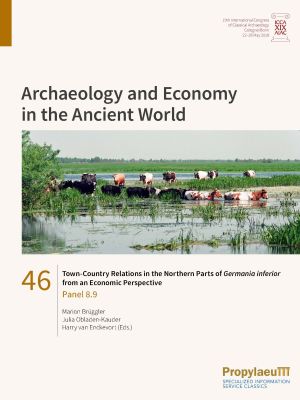
Zitationsvorschlag
Lizenz

Dieses Werk steht unter der Lizenz Creative Commons Namensnennung - Weitergabe unter gleichen Bedingungen 4.0 International.
Identifier
Veröffentlicht
Town-Country Relations in the Northern Parts of Germania inferior from an Economic Perspective
Panel 8.9
Die Provinz Germania inferior ist ein interessanter Kandidat für die Forschung zu Stadt-Land-Beziehungen. Während ihr südlicher Teil an das Verbreitungsgebiet der oppida grenzt, gab es in ihren nördlichen Teilen keine eisenzeitliche Tradition größerer Siedlungen. Dennoch wurden hier in der Römerzeit Städte gegründet: die Colonia Ulpia Traiana (Xanten) und die Municipia Ulpia Noviomagus (Nimwegen) sowie Forum Hadriani/Municipium Aelium Cananefatium (Voorburg). Ein wichtiger Wirtschaftsfaktor der damaligen Zeit war die römische Armee mit ihren zahlreichen Kastellen entlang des Niederdeutschen Limes. Diese massiven und neuen Ansammlungen von Personen, die nicht primär in der Nahrungsmittelproduktion tätig waren, müssen eine Herausforderung für die Versorgung mit Lebensmitteln und anderen Gütern gewesen sein.
Dieses Panel fasst die Stadt-Land-Beziehungen in zwei civitates zusammen und vergleicht sie: die civitas Cugernorum mit ihrer Hauptstadt Colonia Ulpia Traiana und die civitas Batavorum mit ihrer Hauptstadt Municipium Ulpia Noviomagus. Welche Versorgungsstrategien für die Städte lassen sich ausmachen? In welcher Weise haben die Primärzentren das Land beeinflusst? Gibt es Unterschiede zwischen den civitates? Unterscheiden sie sich von den civitates in den südlichen Teilen von Germania inferior? Und wenn ja, was sind die Gründe hierfür? Ein weiterer Schwerpunkt sind Fragen methodische Art, wie z.B.: Können wir diese Fragen mit den Daten, die uns vorliegen, überhaupt beantworten? Und wenn das nicht der Fall ist, welche anderen Methoden können angewandt werden, um einen tieferen Einblick in diesen Aspekt der römischen Wirtschaft zu gewinnen?






